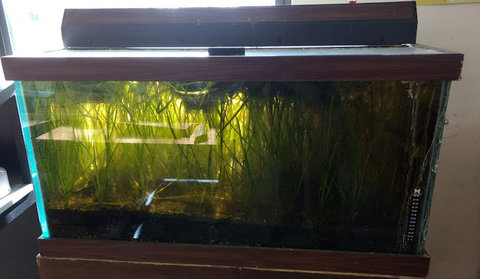I hate to play necromancer and raise this thread from the dead but I recently discovered that I had (accidentally) replicated some of the conditions that spawned this thread in the first place. I present this tale for your edification.
First, what did I replicate?
A heavily planted tank with deep substrate, a decent number of (small) fish, no water changes (only top-offs) for about a nine months, and a final reading of 0 across all nitrogenous waste products.

This happened through a series of bizarre accidents. Several years ago when I took my current job there were a number of fish tanks in a teaching lab that were, frankly, filthy cesspools. I drained these and slowly set them up as teaching display tanks. A 55-gallon at one end of the room became my largest attempt at an ecosystem tank ever. I've done these before in 2-liter soda bottles. The basic idea is to create a self-sustaining ecosystem in a closed system (normally literally sealed) by adding water and mud from a local still-water ecosystem and letting things sprout and hatch. (Current record: eight years. Largest animal: copepods.) So I took this tank, stripped everything down, and then split the substrate into a rocky side and a muddy side. The substrate included some potting soil that was in lab and a lot of mud from a local wetland and the water ended up being multiple samples from every natural body of water I stuck my containers into for a span of two years. Fast forward a few years. At this point I've dumped dozens of plant and invertebrate species into this tank and it's green with plants and the water seethes with tiny animals. It's also got a tank light, sits in front off a window, and has a bubble wall and an overflow-spray bar water circulation system through a small sump. No technical filtration, though, and since it's an ecosystem tank no maintenance beyond replacing evaporated water.
At this point I begin to need a ready supply of feeder fish for some of my research on predatory strategies in larger fish. My guppy breeding experiment needs to be scaled up and the fry are being eaten, so I throw the guppies into the ecosystem tank without changing anything. It works brilliantly, and I soon have guppies everywhere. Which creates a problem, because every time I try to siphon water out I siphon guppy fry out. I promise myself I'll work out a way to siphon out water without siphoning out guppies "soon". Nine months later I realize that it's been a while since I moved guppies into the tank without a single actual water change and make sure my RA tests the guppy tank along with a test on another tank that we are concerned about. The test shows nitrates in that tank, so it works, but everything reads zero in the guppy tank.
So, do I believe that deep substrate is magical? No. (Although I did use a lot of powdered unicorn horn in the original tank layout.) I think this is what happened (and what may be happening in the original LFS).
1. The plants, obviously.
2. The deep substrate....as a support for so many plants. Not only does it hold a lot of roots but it also started with a lot of nutrients and once I started feeding a breeding colony of guppies it would trap extra nutrients. It's totally impossible to vacuum this substrate.
3. Algae. Not surprisingly, with this much light there's a problem with green hair algae growing, sometimes in big tangles, on the back of the tank. I occasionally just pull it out because it's unsightly (as I suspect an LFS owner would), but it also tears loose in tangles and sticks to the overflow teeth, which can cause issues if I let too much of it sit there, so I pull that out. As it happens, I also keep telling myself that I'm going to use the biomass of the algae for something and so I've been dumping it all into a bucket next to the tank, and so I know that in the past nine month I've removed enough algae that when dried it takes up about as much room as five of my own closed fists would. I suspect that this is the missing nitrate right here.







